Specify and procure FF&E and OS&E at scale with Fohlio today. Empower teams to move faster and improve their operational workflow with specification, prototyping, procurement, collaboration, and analytics tools.
This article builds on ideas from our earlier post, The Interior Design Firm’s No-Nonsense Guide to Cost Analysis & Budgeting, by focusing on the specific procurement KPIs that help firms track budget variance, streamline purchase orders, and strengthen supplier and client relationships. If cost analysis shows you what you’re spending, KPIs show you how well you’re managing it.
Onto the actual blog:
Procurement is one of the most overlooked—but most powerful—drivers of success in interior design. Designers may win clients with vision and creativity, but it’s procurement that keeps projects grounded in reality: budgets, schedules, vendors, and logistics.
Yet, many firms still manage procurement through scattered spreadsheets and endless email chains. That’s a recipe for missed deadlines, blown budgets, and unhappy clients.
The smarter way? Track the right KPIs. Key Performance Indicators give procurement teams the visibility to spot risks, keep suppliers accountable, and forecast outcomes with confidence.
In this article, we’ll unpack the procurement KPIs interior design firms should track, why they matter, and how they can transform project delivery.
1. Budget Variance: The Early Warning Signal
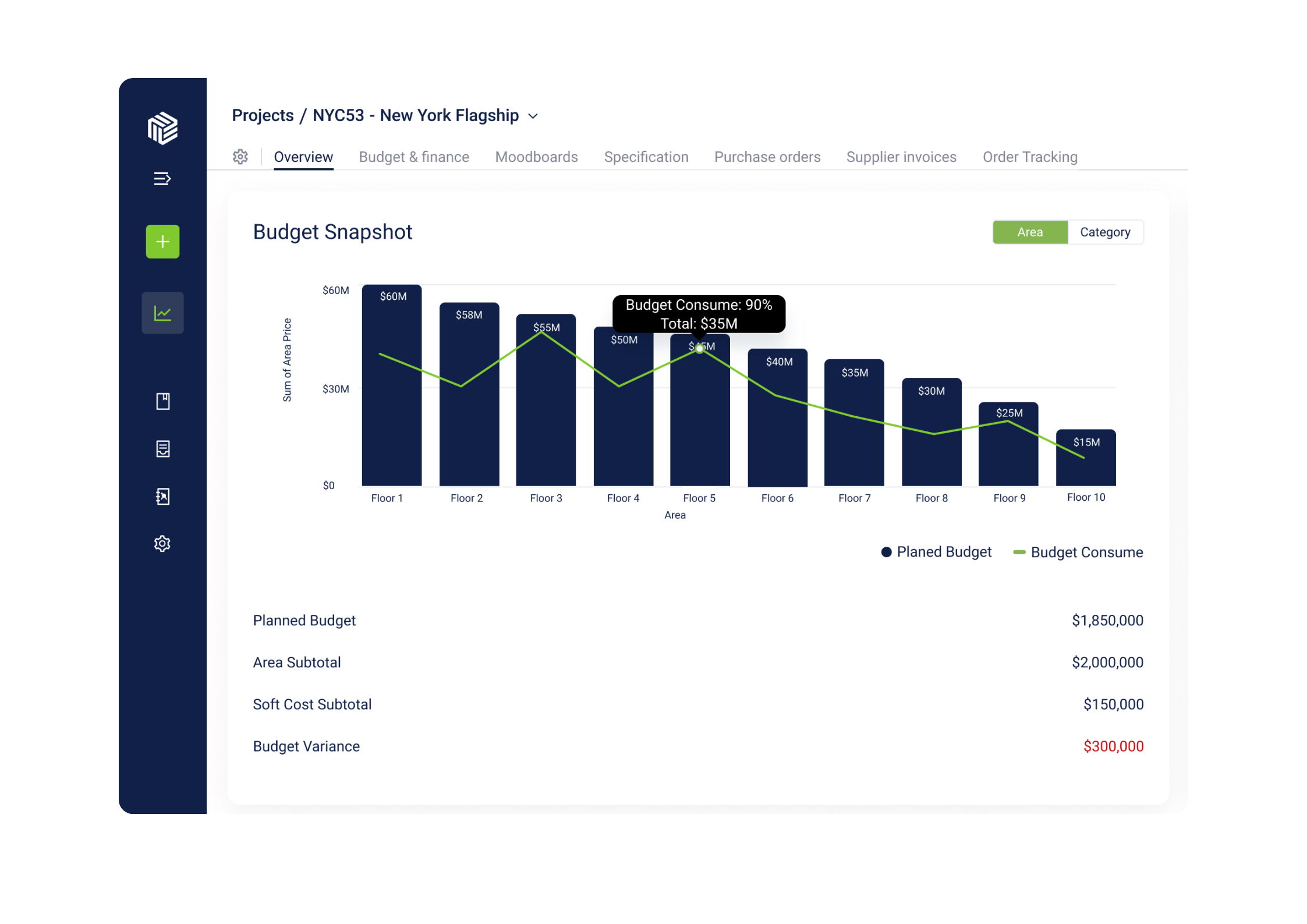
What it is:
Budget variance measures the difference between what you planned to spend and what you’ve actually spent.
Why it matters in interior design procurement:
In design, budget creep is everywhere. Maybe it’s a client who falls in love with a more expensive fabric, or a vendor who increases costs mid-project. Without variance tracking, you only realize you’re over budget at reconciliation—when it’s too late.
Scenario:
Imagine a flagship retail project. Your planned budget for fixtures is $500K. But by the time you get to floor three, supplier quotes are already 20% higher than expected. If you’re not tracking variance in real time, you’ll only discover the overrun when the CFO asks why the final spend ballooned.
Best practices for tracking budget variance:
- Break budgets down by area (floor, room type) or category (FF&E, OS&E).
- Track not just total spend, but percentage consumed versus percentage of work completed.
- Flag any variance greater than 10% for immediate review.
Procurement insight:
Variance is less about the number itself and more about the story it tells. If you consistently see overruns with a certain supplier, it’s time to renegotiate—or replace them.
If you’re managing projects across multiple regions, you’ll also want to read: 6-Steps on How to Build a Global Spec Management System That Keeps Products, Pricing, and People Aligned
2. Purchase Order Progress: Bottleneck Detector
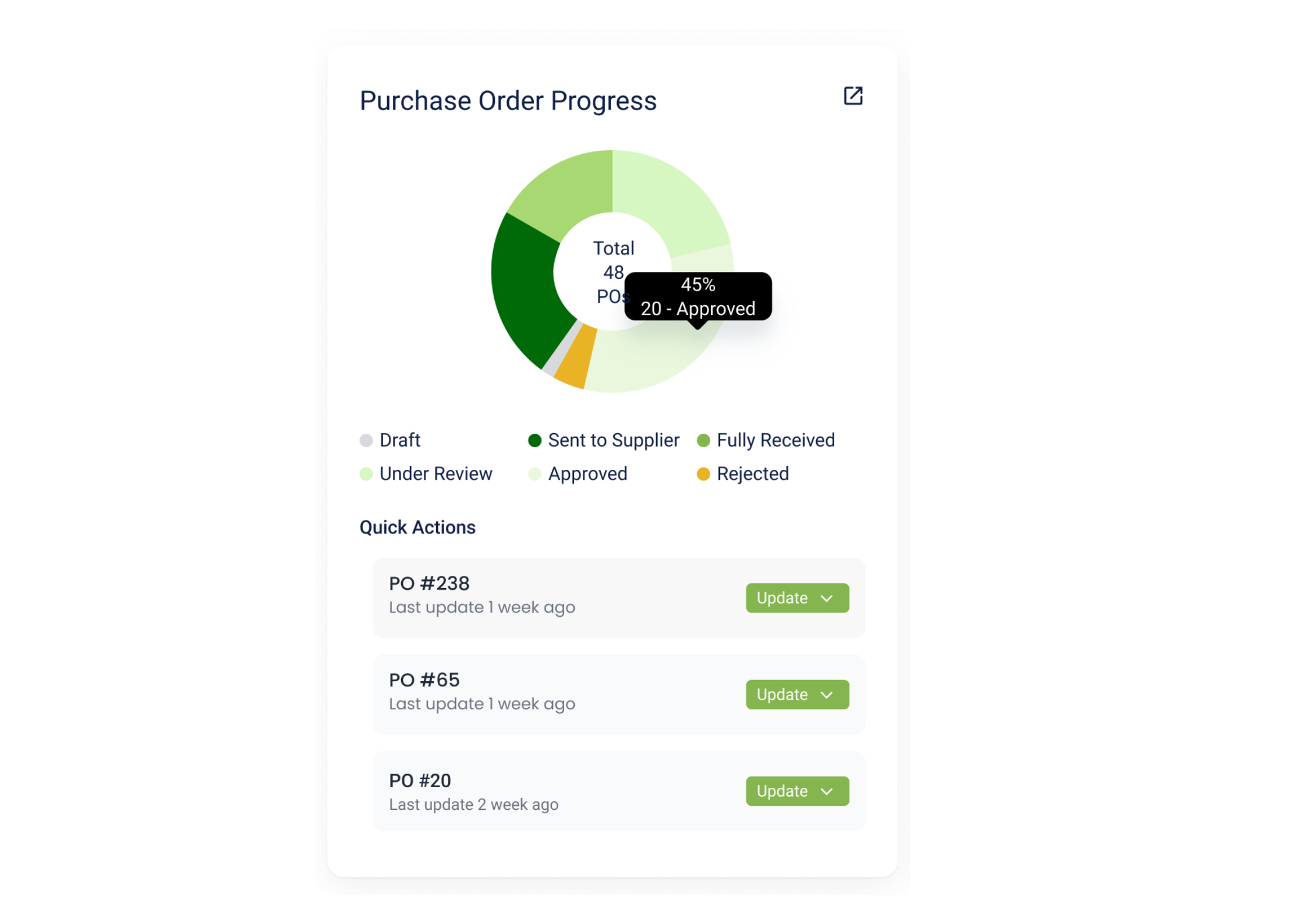
What it is:
A KPI that measures how POs move through your workflow—from draft to review, approval, sent, and received.
Why it matters in interior design procurement:
Procurement is a domino effect. A PO stuck in review delays supplier production. That delays delivery. That delays installation. Suddenly, your grand opening date is at risk.
Scenario:
You send 48 POs for a hotel project. Two weeks later, only 20 are approved and none have been received by suppliers. When you finally check in, you realize client-side approvals are bottlenecking everything. If you had tracked PO status daily, you could have nudged the right stakeholder before losing weeks.
Best practices:
- Measure % of POs at each stage.
- Track average approval cycle time per client.
- Identify recurring bottlenecks (is it always legal review? A particular client approver?).
Procurement insight:
Don’t just chase approvals—analyze them. If certain clients take twice as long to approve POs, bake that into your project timeline and billing structure.
Fast-growing firms face unique procurement challenges—see Why Fast-Growing Interior Design Firms Break: How to Scale Design Ops for Multiple Project Types for strategies to keep operations aligned as you grow.
3. Supplier Invoice Health: Cash Flow Guardian
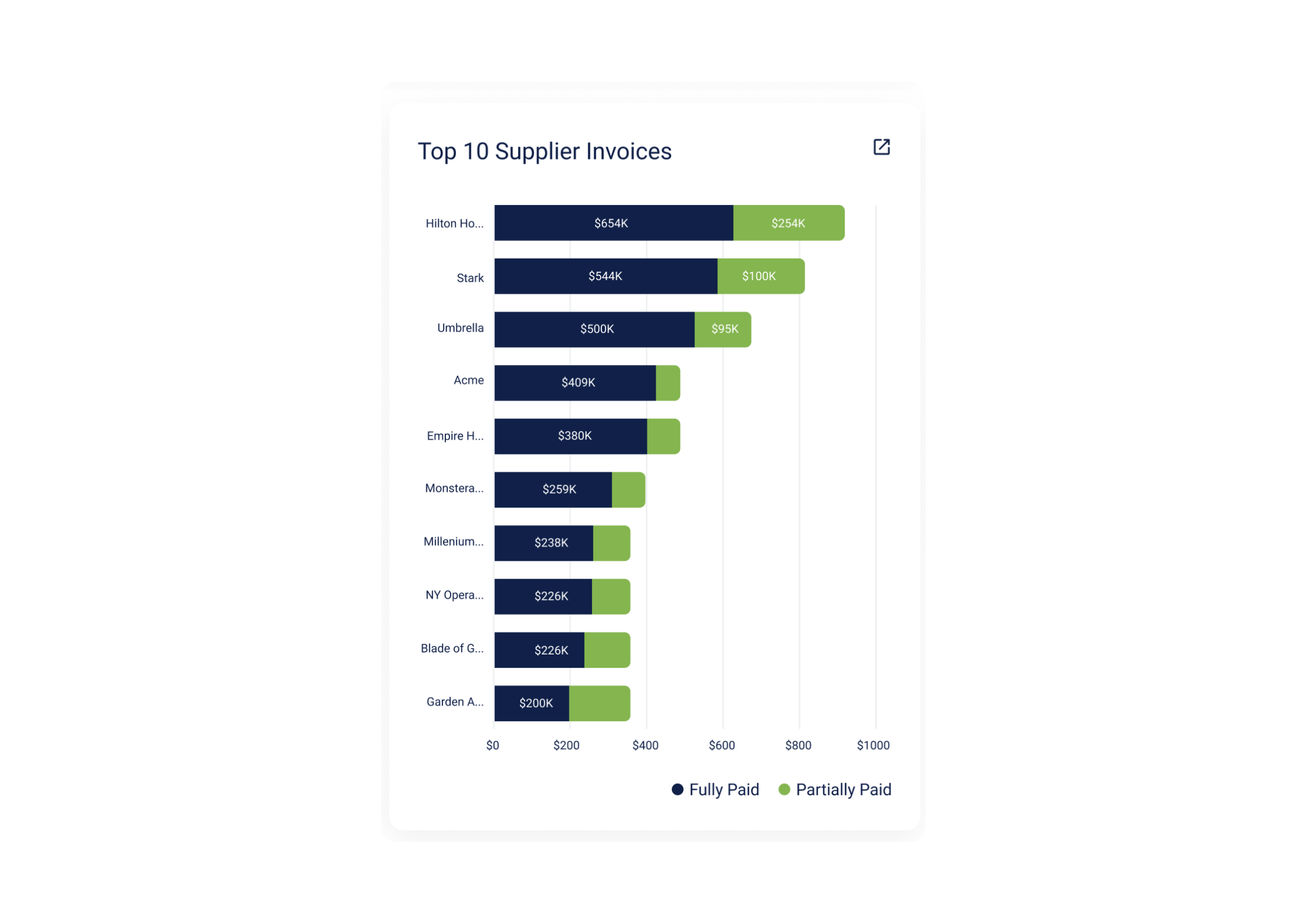
What it is:
Tracking invoices by supplier, along with payment status (fully paid, partially paid, overdue).
Why it matters in interior design procurement:
Suppliers are the lifeblood of design projects. Pay late, and you strain the relationship. Pay inconsistently, and you lose leverage in negotiations. Ignore invoices, and you risk duplicate payments that eat into margin.
Scenario:
Your top supplier accounts for $650K in invoiced items across multiple projects. Without clear visibility, your AP team pays one invoice twice—and delays another. The supplier halts shipments until the mess is sorted, costing you six weeks on a high-profile project.
Best practices:
- Rank top suppliers by invoiced amount.
- Track % of invoices fully paid vs. partially paid.
- Monitor average payment days and overdue amounts.
Procurement insight:
Invoice health isn’t just about paying on time—it’s about negotiating power. The more consistently you pay, the more leverage you have to secure bulk discounts, better terms, or priority fulfillment.
4. Client Invoice Cycle: The Cash Flow Reality Check
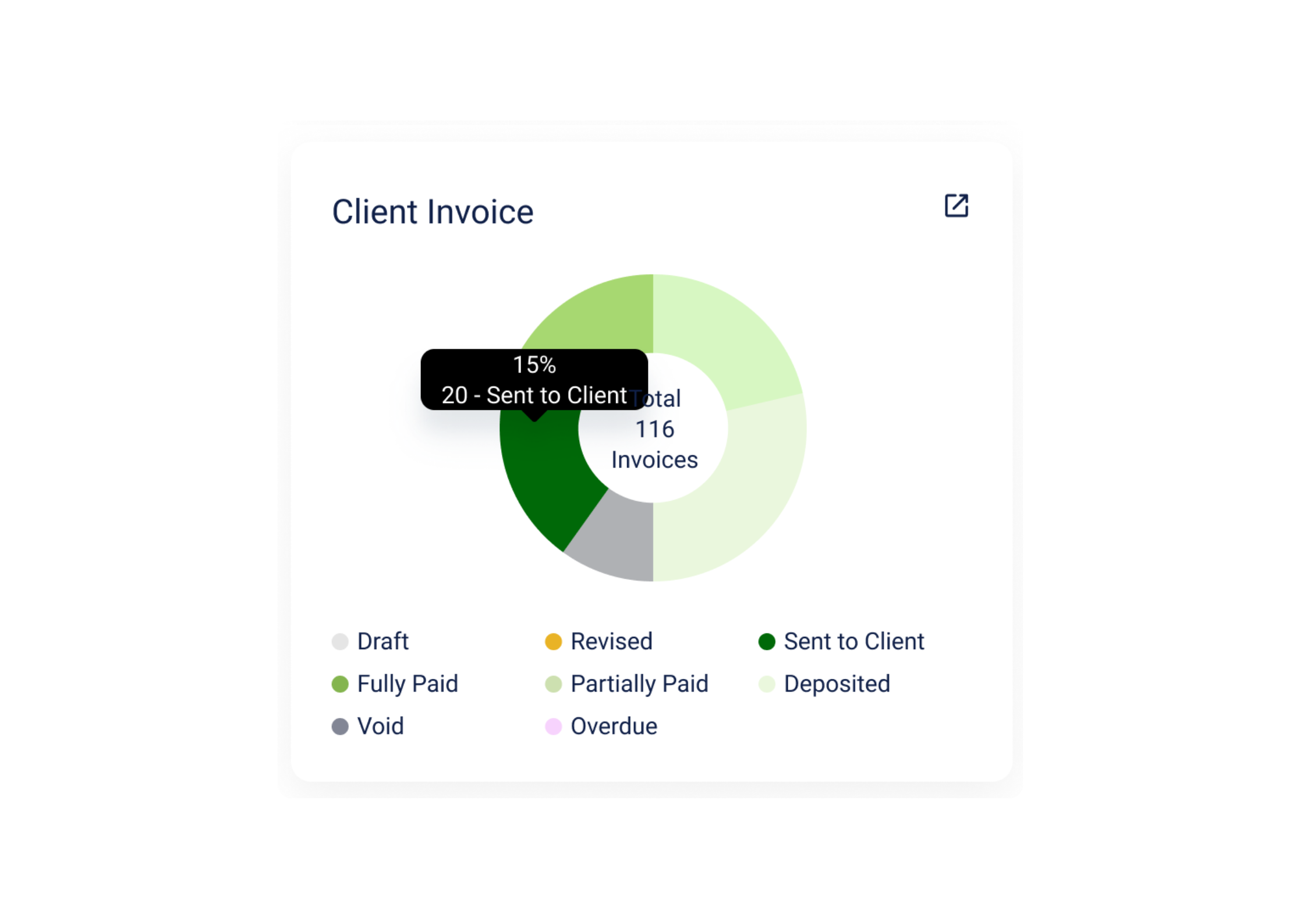
What it is:
Monitoring invoices sent to clients, along with payment status and turnaround times.
Why it matters in interior design procurement:
Procurement teams often advance payments to suppliers long before clients reimburse them. If client invoices lag, your firm becomes a bank—fronting cash and carrying risk.
Scenario:
On a residential project, you deposit 50% upfront with suppliers. But the client takes 90 days to pay their invoice. Meanwhile, you’re funding supplier progress out of pocket. The project may look profitable on paper, but your cash flow tells another story.
Best practices:
- Track % of invoices sent, deposited, or overdue.
- Measure days sales outstanding (DSO).
- Flag clients with chronic delays for contract renegotiation.
Procurement insight:
Cash flow is the silent killer of interior design firms. Tracking the client invoice cycle exposes which projects are profitable not just in theory—but in reality.
5. Sales Quote Conversion: From Idea to Approval
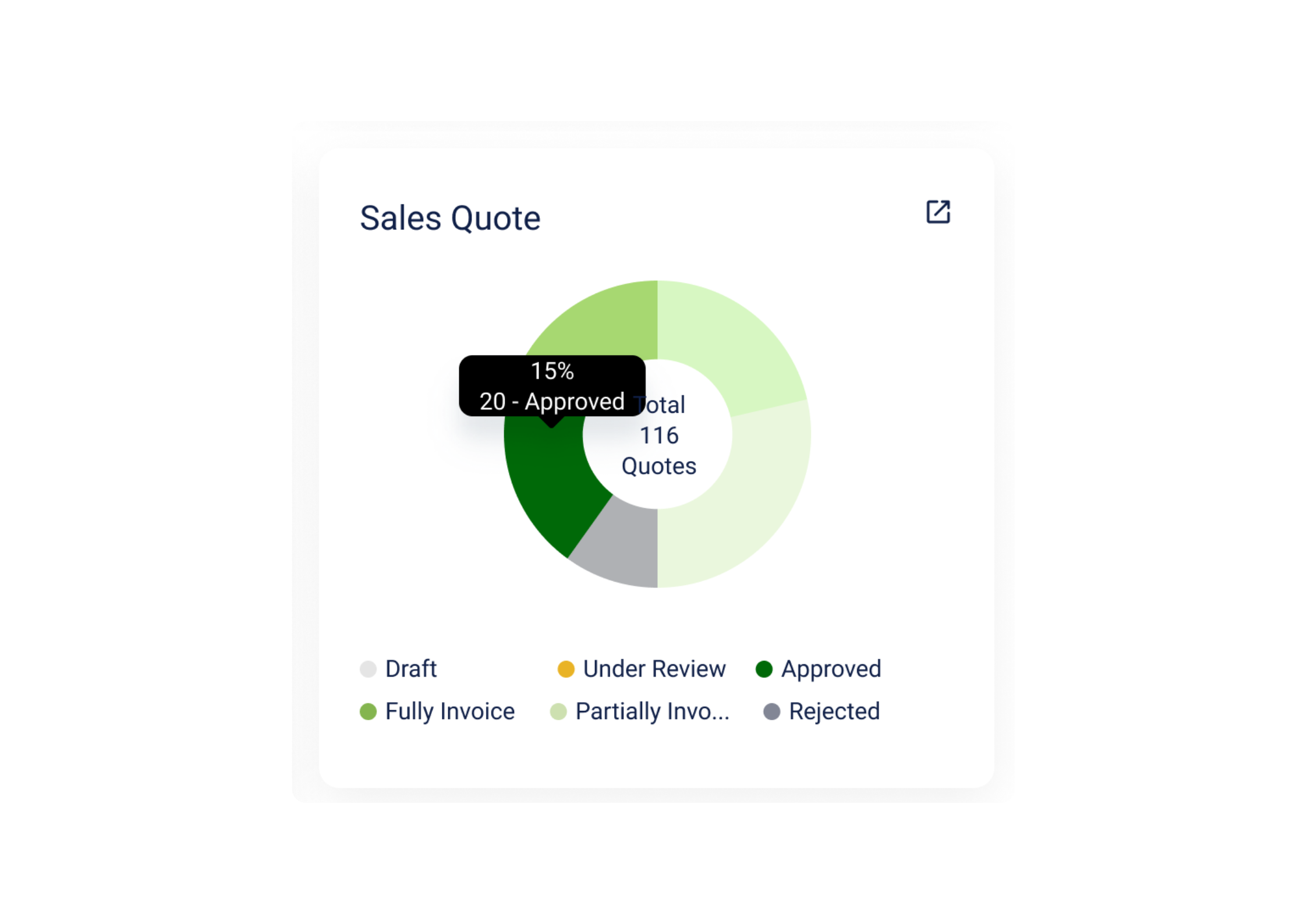
What it is:
The percentage of quotes that turn into approvals (and how fast).
Why it matters in interior design procurement:
Design intent doesn’t pay the bills—approved quotes do. Until quotes are approved, procurement can’t move forward, suppliers can’t produce, and timelines stay frozen.
Scenario:
You send 116 quotes for a commercial build-out. Only 20 are approved after two weeks. Procurement is paralyzed, and installation deadlines are looming.
Best practices:
- Track approval rates per client or project type.
- Measure average time to approval.
- Compare rejected quotes to understand where pricing or design intent missed the mark.
Procurement insight:
This KPI doubles as a design feedback loop. If quotes are consistently delayed or rejected, the problem may not be procurement—it may be misalignment between design and client expectations.
6. Supplier Performance: The True ROI of Vendor Relationships
What it is:
KPIs that measure vendor reliability, responsiveness, and quality.
Why it matters in interior design procurement:
A single underperforming supplier can tank a project. Tracking supplier performance ensures you’re not just buying the cheapest option—you’re investing in the most reliable partner.
Scenario:
Supplier A offers cheaper chairs but delivers late 30% of the time. Supplier B is pricier but has a flawless delivery record. Over multiple projects, Supplier B saves you thousands in avoided delays and rework.
Best practices:
- Measure % of on-time deliveries.
- Track average lead time per supplier.
- Record rejection/revision rates.
Procurement insight:
Supplier KPIs help you build a vetted vendor library. This reduces risk, strengthens client trust, and gives you data-driven confidence in vendor negotiations.
For more on aligning procurement with client and vendor expectations, check out: The Ultimate Guide to Managing Internal and External Stakeholders for Interior Design Projects
Why Dashboards Make These KPIs Actionable
-1.png?width=720&height=885&name=image%20(3)-1.png)
Tracking KPIs is only half the battle—the real challenge is making them visible, timely, and actionable. Too many firms bury procurement data in spreadsheets or siloed systems.
Dashboards consolidate KPIs into a single source of truth:
-
Real-time visibility: See budget variance or stalled POs before they derail timelines.
-
Cross-project insights: Spot trends in supplier performance across multiple builds.
-
Decision-ready data: Instead of waiting for monthly reports, act on daily updates.
When dashboards are built for procurement, they become less about reporting and more about prevention—catching risks before they turn into crises.
Procurement in interior design isn’t just about placing orders. It’s about orchestrating budgets, suppliers, timelines, and client expectations into a flawless project delivery.
By tracking the right KPIs—budget variance, PO progress, supplier invoices, client invoicing, quote conversions, and supplier performance—you create the visibility to run procurement like a strategic driver of business, not just an operational necessity.
And with smarter tools to consolidate and visualize these KPIs, procurement teams can finally get out of reactive mode—and into proactive leadership.
Specify and procure FF&E and OS&E at scale with Fohlio today. Empower teams to move faster and improve their operational workflow with specification, prototyping, procurement, collaboration, and analytics tools.
